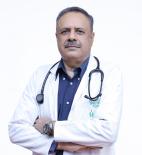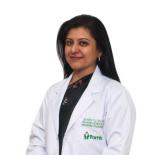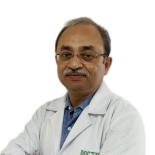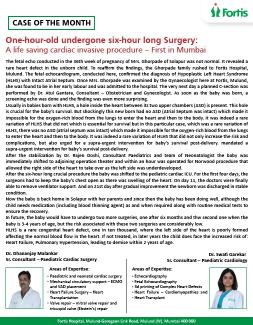About Paediatric Pulmonology
What is Pediatric Pulmonology
Pediatric pulmonology focuses on diagnosing, treating, and managing respiratory disorders in children (from infancy to adolescence). This discipline comprises multiple conditions that affect the lungs and respiratory system and requires a multidisciplinary approach for efficient patient care. A pediatric pulmonologist helps in the early recognition of the condition, symptom management, disease progression prevention, and quality of life improvement.
Scope of Pediatric Pulmonology
Pediatric pulmonologists are trained to address various respiratory issues in children, including:
- Asthma: A chronic inflammatory condition characterized by airway constriction, causing symptoms such as wheezing, coughing, and shortness of breath
- Cystic Fibrosis: A genetic disorder that affects the lungs and digestive system, where thick mucus blocks airways and leads to recurrent infections
- Pneumonia: A lung infection caused by bacteria, viruses, or fungi, causing inflammation and fluid accumulation in the air sacs
- Bronchiolitis: A lower respiratory tract infection in infants characterized by inflammation of the small airways
- Congenital Problems: Structural abnormalities of the respiratory system present at birth, such as congenital diaphragmatic hernia, tracheoesophageal fistula, and pulmonary sequestration
- Sleep Disorders: Conditions such as obstructive sleep apnea, characterized by frequent breathing gaps during sleep due to upper airway obstruction
- Chronic Lung Disease of Prematurity (CLD): Also known as bronchopulmonary dysplasia (BPD), CLD occurs in premature babies and is marked by an abnormal lung development
Diagnosis
Accurate diagnosis forms the cornerstone of pediatric pulmonology. The various diagnostic modalities include:
- Medical History and Physical Examination: In-depth assessment of symptoms, family history, and environmental factors
- Pulmonary Function Testing (PFT): Measurements of lung function, including spirometry, which assesses airway obstruction, and lung volumes, which evaluate respiratory muscle strength and lung capacity
- Imaging Studies: Chest X-rays and computed tomography (CT) scans to diagnose conditions such as pneumonia, bronchiectasis, and congenital anomalies
- Bronchoscopy: A minimally invasive procedure to visualize the lungs and collect tissue samples for biopsy
- Laboratory Tests: Blood tests, sputum cultures, and genetic screening might be performed to identify underlying infections, metabolic disorders, or genetic mutations
Treatment Approaches
Treatment strategies in pediatric pulmonology are tailored to each patient’s specific needs. These strategies include:
- Pharmacotherapy: Medications such as bronchodilators, corticosteroids, antibiotics, and mucolytics are prescribed to relieve airway inflammation, initiate mucus clearance, and prevent respiratory infections.
- Oxygen Therapy: Supplemental oxygen is administered to children with hypoxemia or respiratory distress, either through nasal prongs, masks, or mechanical ventilation in severe cases.
- Airway Clearance: These may include nebulizing (breathing in a mist that sends medicine directly to the lungs), chest physiotherapy (a treatment that vibrates the rib cage to break up mucus in the lungs), CPAP and BiPAP (machines that use air to assist with breathing during sleep), and, in severe cases, ventilators.
- Nutritional Support: Children with chronic respiratory conditions require specialized diets, pancreatic enzyme replacement therapy, and dietary supplements for optimal growth.
- Lifestyle Modifications: Environmental modifications, avoidance of allergens, smoking cessation, and immunizations play essential roles in preventing respiratory complications and improving long-term health.
- Surgical Intervention: Surgical procedures, such as adenotonsillectomy for obstructive sleep apnea, lung resection for pulmonary sequestration, and lung transplantation for end-stage lung disease, are required when medications are no longer effective.
- Multidisciplinary Approach: Collaboration with pediatricians, pulmonologists, nurses, and other specialists, along with family-centered psychosocial support, is crucial to providing comprehensive care.
When To See a Pediatric Pulmonologist?
The symptoms that warrant an evaluation include:
- Cough lasting more than four weeks or recurring frequently
- Audible wheezing or whistling sounds while breathing, especially in children without a history of asthma or allergies
- Difficulty breathing, rapid breathing, or breathlessness during physical activity, rest, or sleep
- Frequent episodes of respiratory infections, such as bronchitis, pneumonia, or sinusitis, despite proper treatment
- Nasal congestion, nasal flaring, chest pain, or fatigue
- Loud snoring, gasping, or pauses in breathing during sleep
- Exercise intolerance, fatigue, chest tightness, or palpitations during physical activity
- Poor weight gain, inadequate growth, or failure to thrive despite adequate caloric intake
- Bluish discoloration of the skin, grunting, retractions (visible sinking of the chest or abdomen with each breath), or feeding difficulties in infants
- Family history of hereditary respiratory conditions
Emerging Technologies in Pediatric Pulmonology
Technologies in pediatric pulmonology are constantly evolving to improve the diagnosis, treatment, and management of respiratory conditions in children.
- Telemedicine: Virtual consultations and remote monitoring platforms enable pediatric pulmonologists to care for children in remote areas or those unable to travel.
- Smart Inhalers and Monitoring Devices: These devices use sensors to track medication usage and inhalation techniques in asthma for better medication adherence and disease management.
- Precision Medicine: Advances in genetic testing and biomarker analysis enable personalized treatment approaches tailored to each patient’s genetic makeup and disease characteristics.
- Air Quality Monitoring Systems: IoT (Internet of Things) devices and sensors can monitor indoor and outdoor air quality, detecting pollutants and allergens that might exacerbate respiratory symptoms.
- Virtual Reality (VR) Therapy: Immersive VR experiences can engage pediatric patients in therapeutic exercises and breathing techniques, improving treatment outcomes and adherence.
- 3D Printing in Airway Reconstruction: 3D printing technology enables the creation of patient-specific airway models for surgical planning and simulation in children with congenital airway anomalies.
- Artificial Intelligence (AI): AI algorithms help radiologists interpret the results of imaging modalities, such as chest X-rays and CT scans, more accurately and efficiently.
- Gene Therapy: Advances in gene editing technologies, like CRISPR-Cas9, aim to correct the underlying genetic mutations or restore normal lung function in pediatric patients.
In conclusion, pediatric pulmonology encompasses a broad spectrum of respiratory disorders affecting infants, children, and adolescents. Through advancements in diagnostic tools, therapeutic interventions, and multidisciplinary care approaches, pediatric pulmonologists at Fortis strive to provide comprehensive and personalized care to young patients, optimizing their respiratory health and quality of life.
Our Team of Experts
View allBreakthrough Cases
View allOur patient’s stories
View allRelated Specialities
Other Specialities
-
Explore Hospitals for Paediatric Pulmonology
-
Explore Doctors for Paediatric Pulmonology by Hospital
Doctors in Fortis Flt. Lt. Rajan Dhall Hospital, Vasant Kunj Doctors in Fortis Hospital, Anandpur, Kolkata Doctors in Fortis Hospital, Noida Doctors in Fortis Hospital, Rajajinagar, Bengaluru Doctors in Fortis Memorial Research Institute, Gurgaon Doctors in Fortis Hospital, Mulund, Mumbai Doctors in Fortis Hospital, Shalimar Bagh, New Delhi


















